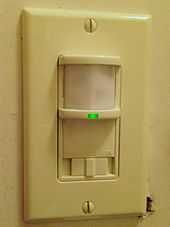Occupancy sensor
An occupancy sensor is a lighting control device that detects occupancy of a space by people and turns the lights on or off automatically, using infrared, ultrasonic or microwave technology. Occupancy sensors are typically used to save energy, provide automatic control, and comply with building codes.
Three basics types of occupancy sensors are:
- Passive infrared sensor, which works on heat movement detection. Inside of device is a pyroelectric sensor calibrated to detect infrared radiation radiated by human body movement. Based on the detection, the sensor operates and starts lighting load connected to it.
- Ultrasonic sensor, similar to radar. It works on the doppler shift principle. An ultrasounic sensor will send high frequency sound waves in area and will check for their reflected patterns. If the reflected pattern is changing continuously then it assumes that there is occupancy and the lighting load connected is turned on. If the reflected pattern is the same for a preset time then the sensor assumes there is no occupancy and the load is switched off.
- Microwave sensor. Similar to the ultrasonic sensor, a microwave sensor also works on the doppler shift principle. A microwave sensor will send high frequency microwaves in an area and will check for their reflected patterns. If the reflected pattern is changing continuously then it assumes that there is occupancy and the lighting load connected is turned on. If the reflected pattern is the same for a preset time then the sensor assumes there is no occupancy and the load is switched off. A microwave sensor has high sensitivity as well as detection range compared to other types of sensors.
References
- ↑ Product Specification for PR150-1L/PR180-1L. Leviton. Retrieved 6 September 2014.
- U.S. Patent 4,225,808 Selective illumination invented by Remo Saraceni US 4,225,808 A
http://www.google.com/patents/US4225808?hl=it&dq=US+Patent+No:+4,225,808#v=onepage&q=US%20Patent%20No%3A%204%2C225%2C808&f=false US Patent No: 4,225,808
